Unique Tree Bark Provides Winter Interest
By Pat Dickey, Fairfax Master Gardener
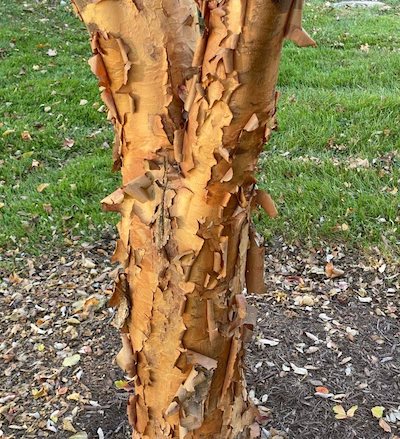
Paperbark Maple
Winter in the garden can be a time of reflection, but also can be an opportunity to learn. Trees and their unusual and attractive bark structures are more exposed without their foliage, and the snow that has fallen also accentuates their beauty. We will look at many notable trees with their unique bark, but first I will explain why their bark has many different and beautiful characteristics to see.
As a tree matures, the outer bark tissue becomes non-living and is pushed outward as the tree trunk expands with growth. Outer bark tissue is also called cork and creates a pattern that is species-specific. The outer bark helps to prevent water loss through evaporation. It also protects against attacks by insects and disease and insulates the tree from temperature swings. Some trees are also protected by their bark from possible fires.
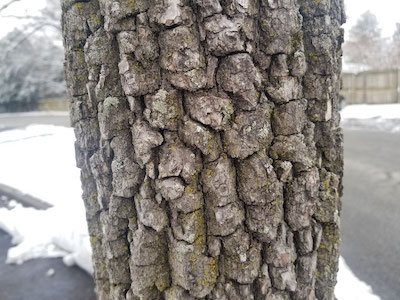
American Persimmon bark
As a tree grows and expands, the outer bark stretches and tightens. Eventually, the pressure causes it to split, crack or flake. When there is some damage from rain, ice, wind and snow, you will see a lot of variability in the bark. Irregularly shaped plate-like sections may fall away from the tree and reveal a beautiful mosaic of deeper bark that is white, tan, green or other colors. This appears like a prominent map-like pattern on the bark, similar to desert camouflage.
When a tree sheds its bark, it is a natural process called exfoliation. The bark peels off of a tree in thin, flat scales or layers exposing the new bark. Trees are genetically designed to do this, and the trees should be left to shed their bark naturally. Exfoliating bark is a tool for survival to ward off unwanted pests such as scales or other insects. It also allows trees to eliminate bacteria, fungi, lichens and mosses.
Trees have also developed soft, spongy areas in the bark called lenticels that allow gases to pass between the environment and underlying living tissues. The lenticel channels function as pores or breathing holes and appear as thin lines, crossing the outer bark or cork. Many trees have pronounced lenticels that add to their attractive bark.
Here are some of the trees with interesting bark in our winter landscape.
-

Sycamore
American Sycamore or American Planetree Platanus occidentalis has bark that looks like a camouflage pattern. A gray-brown outer bark peels in patches showing light gray or white wood underneath. Older trees are gray-brown and scaly.
- Common Sassafras Sassafras albidum has deeply ridged and furrowed bark. Its color is dark cinnamon to reddish-brown and reveals a reddish-orange color beneath if the outer bark is broken off.
- American Hornbeam Carpinus caroliniana has thin, smooth, gray to bluish bark that is heavily ridged, and its branches have a muscular appearance. Older branches develop into a slate gray color and have a smooth, irregularly fluted appearance.
-
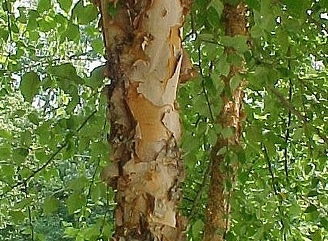
Peeling River Birch bark
River Birch Betula nigra is more attractive without its leaves. It has salmon- to rust-colored bark that develops papery scales. It exfoliates horizontally with several colors that are creamy to orange-brown, and the older trees develop coarse scales.
- Paperbark Maple Acer griseum has very unique reddish curling bark. Exfoliating patches reveal a lighter tan or salmon color underneath. Peeling bark begins in the second year.
- Common Persimmon Diospyros virginiana has gray-brown bark with orange in its fissures when young. Later, it becomes much darker, breaking up into square scaly thick plates that resemble charcoal briquettes and are very unique.
- Dawn Redwood Metasequoia glyptostroboides has reddish-brown bark that is fibrous and stringy when younger. It then develops a buttressing, supportive base and an irregular fluted bark pattern. It exfoliates in strips with a rope-like appearance.
- Red Oak Quercus rubra has flat gray areas in its bark intermingled with ridged and shallow furrows. The shallow furrows form a pattern resembling ski tracks.
- Kousa Dogwood Cornus kousa has smooth light brown bark on young trees. Older trees begin to exfoliate with small patches forming a gray-tan and brown camouflage pattern.
-
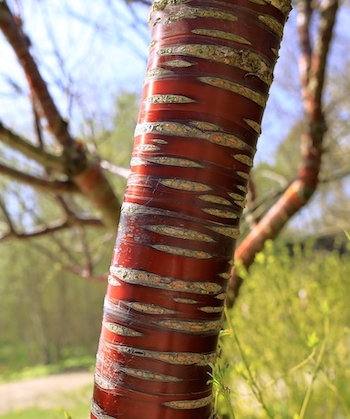
Birch Bark or Tibetan Cherry
Birch Bark or Tibetan Cherry Prunus serrula can be seen as an ornamental specimen tree. Its bark is glossy red-brown to copper-brown with long horizontal lenticels. It may peel in horizontal strips. Most stunning in winter when bark is fully exposed.
- Lacebark Pine Pinus bungeana has exfoliating bark that reveals patches of white, green and purple skin resembling camouflage. Older trees turn solid white.
- Redosier Dogwood Cornus sericea, a native shrub, has red stems of dark blood red, dark purple or bright red. Cultivar ‘Cardinal’ is bright red. It has numerous lenticels on its bark. Yellow Twig Dogwood ‘Flaviramea,’ is also stunning with yellow stems.
- Shagbark Hickory Carya ovata has smooth and gray bark on young trees. Later the bark becomes broken into long wide plates that attach in the middle to the tree and curve away from the trunk. This results in a coarsely shaggy appearance.
-
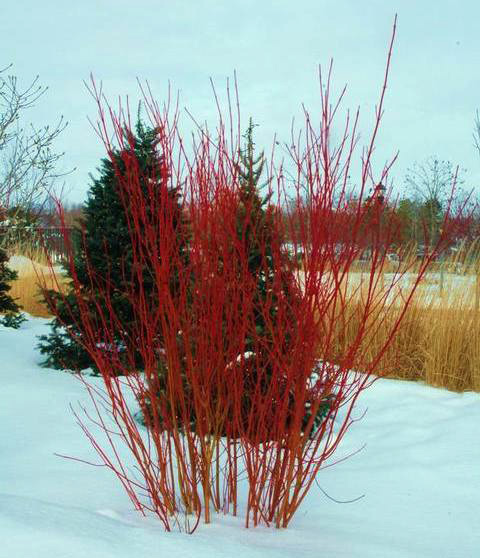
Redosier dogwood
Virginia Stewartia Stewartia malacodendron Is an attractive shrub with flaking patchy bark with grays, cinnamon brown and reds. Older shrubs exfoliate into peeling strips.
- Blackgum or Black Tupelo Nyssa sylvatica has young trees that are gray-brown and shallowly and irregularly furrowed. Older trees have blocky bark resembling alligator hide. Some trees have an almost scaly bark and more variation in bark color.
- Ninebark Physocarpus opulifolius is a native shrub with yellow, orange and red-brown bark. It shreds and exfoliates into long strips on older stems.
- Black Cherry Prunus serotina has smooth bark with numerous short narrow and horizontal lenticels when young. Older bark becomes very dark, nearly black. It breaks up into small rough, irregular upturned plates and looks like burnt cornflakes.
- Eastern Redbud Cercis canadensis has smooth and brown bark when young. It later becomes ridged and furrowed, then scaly and dark gray. It may have some maroon patches and orange coloring in its cracks.
For additional photos of winter bark, see Fairfax Master Gardeners Instagram.
Resources
Virginia Tech Dendrology
North Carolina State Extension Gardener Plant Toolbox
Manual of Woody Landscape Plants, by Michael A. Dirr
Dirr’s Hardy Trees and Shrubs by Michael A. Dirr
Missouri Botanical Garden Plant Finder
Tree Bark, Britannica